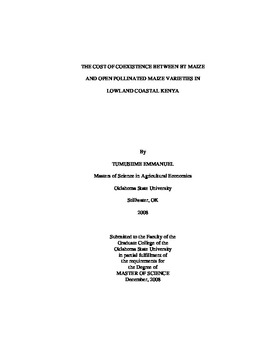| dc.contributor.advisor | Vitale, Jeffrey | |
| dc.contributor.author | Emmanuel, Tumusiime | |
| dc.date.accessioned | 2014-04-15T18:35:23Z | |
| dc.date.available | 2014-04-15T18:35:23Z | |
| dc.date.issued | 2008-12-01 | |
| dc.identifier.uri | https://hdl.handle.net/11244/8305 | |
| dc.description.abstract | The purpose of this study was to assess the spatial distribution of open pollinated maize varieties (OPVs) in lowland coastal Kenya and analyze how this distribution affects the economic and practical feasibility of the implementation of coexistence measures between Bt maize and OPVs. The study used both primary and secondary data. Primary data was spatially generated by a hand held GPS and farmer surveys in lowland coastal Kenya. This data was analyzed using GIS arc view software and the least squares mean procedure. Agroecological zones were used as the reference spatial strata. Secondary data was a review of the existing coexistence studies and economic performance of Bt maize. This information is analyzed and used to determine the economic and practical impacts of the different coexistence measures in lowland coastal Kenya. The findings showed that local maize varieties are popular in the region, most of it grown in zone Cl3 along the coast. However, hybrid and improved varieties are equally popular in Cl4 and Cl5. The size of maize fields didn't differ significantly between zones. The estimated mean size of maize fields across the region was 1.7hec. The distribution of the distances between maize fields was skewed to the right with an estimated mean size of 129.2m across the region. Consistent with Ingram (2000) separation distance recommendations, we found that at separation distance of 100m, 150m and 200m, approximately 48%, 52% and 53%, respectively, of the farmers would not meet the minimum isolation distance requirement. Consistent with Ingram (2000) separation distance recommendations, we found that at separation distance of 100m, 150m and 200m, approximately 48%, 52% and 53%, respectively, of the farmers would not meet the minimum isolation distance requirement. These benefits are partially offset by reduction of GM maize fields to allow for spatial separation. On average across the region, the cost of separation was found to be approximately USD21.2/hec and USD72.1/hec if the minimum separation distance is 150m and 200m respectively. At separation distances of 150m and 200m, the costs of separation represented 27.2% and 92.4%, respectively, of the gross benefits. | |
| dc.format | application/pdf | |
| dc.language | en_US | |
| dc.publisher | Oklahoma State University | |
| dc.rights | Copyright is held by the author who has granted the Oklahoma State University Library the non-exclusive right to share this material in its institutional repository. Contact Digital Library Services at lib-dls@okstate.edu or 405-744-9161 for the permission policy on the use, reproduction or distribution of this material. | |
| dc.title | Cost of coexistence between BT Maize and Open Pollinated Maze varieties in Lowland Coastal Kenya | |
| dc.type | text | |
| dc.contributor.committeeMember | Adam, Brian D. | |
| dc.contributor.committeeMember | Boyer, Tracy | |
| osu.filename | Emmanuel_okstate_0664M_2918.pdf | |
| osu.college | Agricultural Sciences and Natural Resources | |
| osu.accesstype | Open Access | |
| dc.description.department | Department of Agricultural Economics | |
| dc.type.genre | Thesis | |
